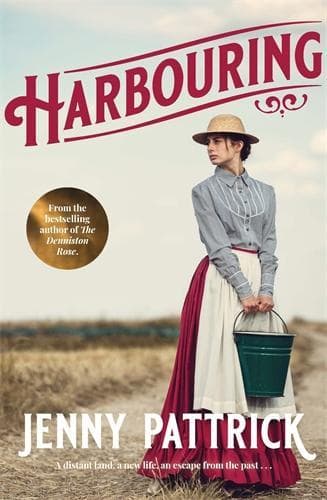Review: Harbouring
Reviewed by Jessie Neilson
Acclaimed writer of historical fiction Jenny Pattrick returns with her tenth novel, which starts with Martha and Huw Pengellin, a young couple in Newport, Wales in the late 1830s, barely getting by, living in one of many identical, rat-infested "hovels" with their baby Alfie.
They hold no illusions about what life has to offer, so when foundry worker Huw's boss, an Englishman and "fat slug," asks to see him, Huw is perturbed. For, as Huw is aware, messages do not come two a penny to the likes of him. In fact, Huw is so desperate that he feels if he lost this "hellish" job, he might as well "curl up...grimy toes and wait for death.” He and Martha are stuck in an eternal winter, with rain-drenched crowded alleyways and smog-laden skies.
It is a tale well too common – but when Huw is offered employment which will take him across the seas to a new colony, he grasps it.
The poverty at the heart of this book is intimated in the book's cover. The photographic image portrays a young woman from much earlier times, apron-wearing and carrying a coal bucket. She is gazing off in one direction, pensively. She is in a serving role yet standing proud. Later we realise this is Martha.
The title matching this image is the unusual and altogether uncommon "Harbouring.” With multiple meanings, it could hint at the action of protecting some secret or knowledge or the safekeeping of emotions such as doubt. It could refer to the quiet nurturing of another. If could also refer to the docking of ships and future "nesting" in this geographical location. Regardless, joined with the visuals, it carries peaceful connotations.
Pattrick focuses on individuals such as Martha and Huw, from working class society seeking to better themselves. First person accounts inform us of their lives and emotions in 1840s Aotearoa New Zealand, where settler life is newly unfurling.
Rather than limit the viewpoint to European settlers, Pattrick also gives a strong voice to a young Māori woman, Hineroa, who has seen better times. From respected lineage, Hineroa's family has been decimated and she has been cast into a bonded role. As traditional Māori lifestyles and the new settler invasion overlap, these characters come together. Conflicts and passions between the two cultures drive the action.
The author's thorough research is evident in this substantial novel, which concentrates on the lower North Island, Te Upoko o Te Ika, and the burgeoning white settlement of Wellington. Through Hineroa's story we are privy to the alliances and confrontations of surrounding iwi, and of the campaigns led by Te Rauparaha and others from up north. There is a firm historical background, which Pattrick's end notes explain clearly.
Harbouring has several surprising narrative turns, resisting predictability. These revolve in part around the clashing ideals of cultures. Onto traditional Māori concepts of spirituality Christianity bombards; antagonism grows against the preaching morality. Pattrick makes no judgements, more a curious observer, with her characters narrating in straightforward prose.
While there are differences, so too are there links. The wonder of childlike spirituality and fairytales is a motif knitting through. Feelings of shame or whakamā and misunderstanding can be put on hold by a retreat to innocence and imagination. The natural world and its ingredients can heal. Likewise, an individual will always know their tūrangawaewae, and as in Welsh, hiraeth, have a longing for home.
Harbouring packs a lot in, portraying a few pivotal years in our country's history, against immense historical background. Characters are resilient while they are suffering. Most but not all hold on to their integrity, reminding the reader of the gruelling conditions for our people who went before.
Reviewed by Jessie Neilson
